Laparoscopic Approach to Pelvic Prolapse
From its beginnings back in 1991, in our Department, the laparoscopic approach to pelvic prolapse has changed considerably over the decade. Initially limited to strict reproduction of the techniques carried out by laparotomy, the introduction of a number of complementary procedures has provided an answer to all the situations encountered in the field of female genital prolapse repair.
Introduction
From its beginnings back in 1991, in our Department, the laparoscopic approach to pelvic prolapse has changed considerably over the decade. Initially limited to strict reproduction of the techniques carried out by laparotomy, the introduction of a number of complementary procedures has provided an answer to all the situations encountered in the field of female genital prolapse repair.
The well-known advantages of laparoscopy - less post-operative discomfort, shorter hospital stay, and so on - were rapidly eclipsed by the innovating aspects of this technique. By adding the precision of endoscopic vision and the advantages of pneumodissection, access has been gained to anatomical spaces that were difficult to reach before. Moreover, the repair procedures could be adjusted under continuous visual control.
The results were encouraging from the beginning and are now excellent with perfect anatomical correction and remarkable functional results.
The time has now come to simplify the techniques and render them reproducible with acceptable operating times.
Preoperative work-up
The preoperative work-up must be very meticulous. Thorough evaluation of all the defects is the only way to ensure a complete repair under one anesthesia, thus preventing functional sequelae and recurrences.
Evaluating the prolapse
Diagnosis of all the defects is the crucial moment of the clinical evaluation. It is essential to stage the defects for each compartment. Standard clinical examination must try to establish the degree of prolapse of the uterus, bladder and rectum. Lateral cystocele with vaginal rugae still present must be distinguished from central cystocele with elimination of the vaginal rugae. The former is due to detachment of the vagina from the arcus tendineus fasciae pelvis while the latter is due to a break of the vesico-vaginal fascia. A systematic check must be made to detect any enterocele.
High rectocele is due to a fascial detachment, and must be distinguished from a low rectocele due to deficient levator ani muscles support.
The muscle tone of the levator ani plate should be assessed for both quality and quantity.
The functional symptoms must be evaluated. Particular attention needs to be paid to urinary incontinence. Three groups of patients need to be distinguished: patients associating pure urinary stress incontinence together with the prolapse, patients presenting hidden urinary incontinence and patients without urinary problems.
Similarly, rectal dysfunctions must be studied: constipation and/or incontinence of fecal matter or gas has to be considered. The anal sphincter needs to be checked, using ultrasound investigation if necessary.
Modern imaging techniques associated with clinical examination enable these problems to be visualized. Thanks to the recent progress made with dynamic MRI and when conditions are optimum, defects in all three areas can be visualized simultaneously and any enterocele can be detected.
Evaluation of urinary function
Urinary function needs to be assessed not only by questioning but also by uro-dynamic investigation, which should be systematic. The main issue to be analyzed is the presence of a urethral sphincteral deficiency, which would require a change in the surgical strategy.
Evaluation of the feasibility of laparoscopy
Although the chances of feasibility of endoscopy has changed fundamentally over the past few years, it is still necessary to select the patients. Laparoscopic treatment of prolapse means that the patient has to undergo an usually protracted general anesthesia with a pneumoperitoneum in a continued Trendelenburg position. In fact, the contra indications are most often connected with anesthesia. However, the indications must also be established correctly for older and obese patients for whom the vaginal route should still be preferred.
Patient preparation
Preparation of the patient is a crucial factor for obtaining the best results from surgery. It must include preparation of the tissues to facilitate post-operative healing and bowel preparation to optimize the endoscopic space.
Bowel preparation
The reason for this practice is to empty the bowel and to enlarge the operating space. Preparing the bowel in case of accidental injury is not the main purpose. Preparation starts with a standard low residue diet which the patient is required to follow for five days prior to operation. Two days before surgery the bowel is emptied by administering a laxative solution such as Xprep®. Finally, the day before the lower bowel should be cleaned with an enema.
Vaginal estrogens
Vaginal estrogens should be prescribed for at least on month prior to surgery. The purpose is to improve the vaginal trophic condition, which will enable better healing.
Vaginal and parietal disinfection
Vaginal disinfection is essential. It should take place the day before surgery, by vaginal irrigation with an antiseptic solution and the installation of a pessary of Btadine®. The abdominal wall must also be disinfected. After showering the day before the operation, the patient is shaved, then the abdominal wall cleaned using an antiseptic solution, paying particular attention to the inner surfaces of umbilicus. Then a dilute solution of Btadine® is applied and the skin covered with a closed sterile dressing fixed in place.
Positioning of the patient
Endoscopic surgery is long and difficult. The procedure needs to be optimized and the operating time kept as short as possible by ergonomic organization of the operation, for which correct positioning of the patient is of main importance.
Anesthesia
Anesthesia is generally administered by endotracheal intubation. Curare is not systematically used but only when parietal distension is not obtained at 12 mm Hg pneumoperitoneum pressure. The general anesthesia may be associated with loco-regional anesthesia such as epidural or spinal blocks to ensure the most comfortable post operative conditions as possible.
Positioning
The patient is placed in a dorsolithotomic position with legs apart and half-bent. This position creates 3 operating spaces: one on the left occupied by the surgeon, another on the right occupied by the first assistant and the third between the legs for the second assistant. The patient's arms are placed along her body to avoid brachial injury. It is better to have two shoulder rests level with the acromion but without any pressure on the neck muscles. The patient's hands must be carefully arranged to avoid any compression of the fingers. A system to warm the patient can be used to avoid chilling.
The patient must be placed right at the lower edge of the table to optimize the movements of the uterine manipulator. The greater the range of movement the manipulator has, the better the tissues will be exposed.
The patient's abdominal wall and vagina must be generously disinfected and the drapes installed before the Foley catheter and uterine manipulator. It is essential that the perineal area is in a sterile environment and accessible to the surgeon who will need to position the manipulator or carry out vaginal or rectal examination.
Bladder catheter
A permanent number 18 Foley catheter is installed, the balloon is filled with 15 cc normal saline and the catheter pulled back as far as possible in order to clearly reveal the bladder neck. The catheter is connected to a bag placed where it can easily be seen in order to keep a constant check on the urine (quantity, color, presence of air in the bag).
Preoperative assessment
Clinical examination
The re-assessment of the prolapse on the operating table once the patient has been anesthetized is essential. In fact, the examination under general anesthesia may provide new information which might modify the operating strategy.Clinical evaluation is carried out using vaginal retractors: it mostly enables to properly assess the aspect of the vaginal walls and to differentiate between prolapse of the upper or lower compartment. Similarly any deviation from the proper vaginal axis can be better evaluated. If hysterectomy is scheduled, the size and mobility of the uterus need to be assessed, and these elements will guide the positioning of the trocars.
(Download QuickTime
here
to view the videos.)
Morphology of the abdominal wall
The patient's general morphology and the aspect of the abdomen are decisive factors when deciding how to organize the operating field and position of the trocars. The ergonomics of movements during the operation are highly dependant on this. A number of elements need to be taken into account:
- The patient's morphology. The most important point to note is the distance between pubis and umbilicus, which will guide in the choice of the positioning of the supra pubic trocar. The supra pubic trocar needs to be located sufficiently high up to make it easy to approach the promontory, open the space of Retzius and apply the sutures. If the distance in question is short, it will be necessary to place the primary trocar above the umbilicus and to move the supra pubic trocar to the umbilical position.
- The distance between the iliac spines: suturing is easier when the trocars are well spaced out. If this distance is short, the trocars should be moved up in order to gain more space.
- The trocars should be positioned where the abdominal wall is thinnest. This will reduce the risk of coming out of the trocars and the difficulty of reinsertion.
- The muscle tone of the abdominal wall will give an idea of how much operating space there will be, and will also affect the positioning of the trocars.
Positioning of the trocars
As a general rule four trocars are needed: three supra pubic trocars and one umbilical trocar. The first trocar to be inserted is always the umbilical trocar, 10 mm in diameter. The final function of this trocar will be decided after carrying out an internal inspection keeping in mind the known data (size of the uterus, patient's morphology). If the uterus is normal or even smaller and there is sufficient distance between pubis and umbilicus, this will be the primary trocar. On the other hand, if the uterus is large or the pubo-umbilical distance is short, then it will be the central operating trocar.
In the great majority of cases, the situation is therefore three supra pubic trocars and one umbilical trocar.
1. The supra pubic trocars: we prefer to use disposable trocars 5 mm in diameter. We have selected trocars made by mtp® (ref: 020105 or 020106 Tuttlingen, Germany). They present the advantage of being light, transparent, with external tapping making them firm in the abdominal wall. They have a star-shaped valve which provides a leak-proof seal even when tying the sutures. Finally, they are reasonable in cost. The lateral trocars are positioned at the level of the anterior superior iliac spines, about two fingers inside the spines and outside the external edge of the rectus abdominis muscles. This means they are located in the vicinity of the oblique and transversus abdominis muscles. The abdominal wall in this area is generally thin, making movements easier. The central trocar is located more or less half-way along the pubo-umbilical line. There should be at least 6 cm between the umbilical primary trocar and the central trocar. In any case the central trocar must be located no lower than the line running between the two external trocars.
2. If the laparoscope is to be inserted into the umbilical trocar, a simple reusable steel trocar is used. We prefer the Karl Storz model (Tuttlingen, Germany), because it has a valve that the surgeon can lower when introducing the optics. This helps to keep the lens clean during insertion and consequently saves considerable time. If the umbilical trocar is to be the central operating trocar, we prefer to use a disposable trocar with a removable reducer device. For reasons we outlined above, we choose the model by mtp® (ref 020174 or 020107, Tuttlingen, Germany).
Under standard conditions (three supra pubic trocars and one umbilical trocar), we prefer to start the operation with three 5 mm trocars for dissection procedures, replacing the central trocar later when suturing takes place (once hysterectomy has been completed).
Organization of the operating field
Positioning the manipulator
The uterine manipulator is an essential instrument for presenting the uterus. It allows manipulation in all directions: elevation, anteversion, retroversion, lateralization and flexing of the uterus forwards and laterally. In addition it enables the presentation of the vaginal fornices and it is equipped with a leak proof seal for maintaining the pneumoperitoneum after colpotomy or extraction of the uterus.
The device presents several concentric shafts. The central shaft has a screwed tip which is inserted inside the uterus. Several sizes of screw are available. The size is chosen according to the size of the uterus. The tip of the manipulator can be inclined by bending the distal handle. Around this shaft there is a more external sheath with a valve covered with ceramic material. This valve can rotate through 360°, and is used to expose the fornices. Finally, around the external sheath there is a system of seals consisting of three flexible disks. These are not introduced into the vagina until near the end of the operation, after the colpotomy.
· Insertion: The Clermont-Ferrand manipulator (Karl Storz Tuttlingen, Germany) must not be inserted until after the patient has been swabbed and draped. It needs to be manipulated by the surgeon under sterile conditions. After exposing the cervix, a hysterometer is used to measure the size of the uterine cavity. The tip is chosen according to the size. The cervix is then dilated up to Hegar dilator n° 8. The device is locked in the zero position and presented at the opening of the cervix. It is important to screw the device until the entire tip is completely inside the uterine cavity. Once this has been achieved, the handle locking control lies on the right.
· Exposure: In most cases each manipulation is preceded by a movement thrusting the uterus towards the patient's head. Anteversion is achieved by combining two movements: pushing on the uterus and anteversion by lowering the handle of the device. This movement places the two uterosacral ligaments under tension and exposes the pouch of Douglas. Similarly the adnexa are exposed by pushing and moving the handle laterally underneath the patient's legs, which are in a lithotomic position, being spread and half bent. The rotating valve can be manipulated at any time and enables the vaginal fornices to be correctly exposed.
Fixing the bowel
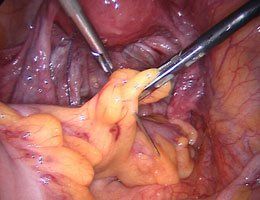
The operating field needs to be carefully organized at the beginning of the operation. This helps to obtain stable exposure without the assistant needing to intervene. To obtain this, the pouch of Douglas is cleared by fixing the sigmoid colon to the abdominal wall. We use two different techniques. The first technique uses a straight needle with a nylon suture. The needle is introduced through the abdominal wall about 5 cm above the left lateral trocar.
The needle is then taken through the fatty tissues of the both sides of the para sigmoid, then back out through the abdominal wall at the same place as before. The sigmoid is lifted with a forceps and the suture tightened over a pad, thus holding the sigmoid in position. The same effect can be achieved with a curved needle introduced into the abdominal cavity. The para sigmoid fatty tissue is lifted and the needle removed via the trocar. The needle is then cut and a Reverdin's needle is introduced through the abdominal wall above the left trocar to grasp the ends of the suture inside the abdomen and bring them outside. They are then fixed using a forceps. After hysterectomy, the vagina or stump of the cervix are suspended against the anterior abdominal wall in similar fashion using a Reverdin's needle.
Identification of the origin of the uterosacral ligaments
The origin of the uterosacral ligaments can be identified at the beginning of the operation. This is where culdoplasty will start. The means of identification may be a mark left with the bipolar coagulation or even better, by leaving a suture as a marker.
Operating strategy
Dissection phases. The dissection phases are carried out in the following chronological order: dissection of the promontory, dissection of the right lateral peritoneum and recto-vaginal space. Then hysterectomy is performed, during which bladder dissection is taken very low. There is good reason for this specific order. The promontory must be dissected firstly because for this part of the procedure it is often needed a more marked Trendelenburg position. In many cases this is possible only at the beginning of the operation. Once this part of the dissection has been completed, the Trendelenburg position can be avoided if anesthesiologic problems required it. Dissection of the spaces where the meshes are to be installed is made easier by the use of the uterine manipulator which improves the access to the various areas. For this reason, this part of the dissection should be carried out prior to the hysterectomy.
Strategic chronology of the phases
The strategic chronology of the operating procedures is important. A clear distinction must be drawn between the dissection and the repairing phase.
Repairing phases: the mesh is positioned first posteriorly, then the culdoplasty is carried out before the mesh is fixed anteriorly. Peritonization of the lower areas comes next, which continues until half of the right peritoneal opening has been closed.
At this point the timing of a Burch procedure needs to be discussed.
If it is desired to follow the traditional procedure, the Burch procedure and the para-vaginal repair required are carried out immediately, postponing the sacral colpopexy. At present, we prefer to fix the mesh to the promontory at this point, completing the peritonization and carrying out the bladder-neck suspension later.
The role of hysterectomy
In the classic procedure the uterus is left in place to avoid opening the vagina with the consequent risks of infection for the mesh. In this case is possible, by laparoscopy, to dissect the spaces without sectioning the round ligaments, to fenestrate the peritoneum in the lower part of the broad ligament in order to place the meshes through the opened spaces.
Today the trend is to carry out hysterectomy, which can be supra-cervical or total. In our experience, supra-cervical hysterectomy is preferable because it offers the advantage of leaving the vagina closed. When hysterectomy is total, vaginal closure should take place along two planes.
The essential difference in comparison with an hysterectomy performed for other indications is the chronology of the operating phases. When treating a prolapse, dissection of the recto vaginal and vesico vaginal spaces precedes the removal of the uterus.
Per-operative antibiotic therapy
We use per-operative antibiotic therapy. This consists of an injection of the latest generation of Cephalosporins as a 1 gram single dose which is repeated if the operation lasts more than four hours.
Operating technique
Dissection of the promontory
The promontory is best approached in laparoscopic surgery by increasing the Trendelenburg position and fixing the sigmoid to the abdominal wall.
The desired position is at the level of L5-S1, or upper part of S1. The anterior common vertebral ligament is isolated.
The median sacral artery and vein are medially reclined or coagulated, if necessary. Particular care must be taken concerning the left iliac vein in obese patients and in those with a low bifurcation of the aorta.


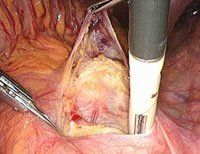

The promontory is identified by palpation with the instruments. After identification of the right ureter and of the lower aspect of the left common iliac vein, the posterior prevertebral parietal peritoneum is pulled upwards by the assistant then incised vertically from the promontory, leaving the ureter laterally. When the peritoneum is opened, the gas penetrates the retro-peritoneal space, facilitating the dissection.
The organs adhering to the posterior plane remain fixed in place whereas all the separable elements move away from the promontory.
Incision of the right lateral peritoneum

Dissection continues vertically to reach the pouch of Douglas. During this dissection, the surgeon needs to pay particular attention to the internal iliac vein while it is crossed, and to the peritoneum covering the utero-sacral ligaments which is not easily dissected. The purpose of this incision is to enable the peritonization of the mesh at the end of the procedure, without damaging the ureter. In fact, a simple peritoneal incision is not enough: a sufficient part of peritoneum must be opened to enable the meshes to be covered without imposing any constraints on the ureter.
Dissection of the recto-vaginal space

The joining point of the two uterosacral ligaments at the level of the torus uterinus is identified. Then the rectum is grasped by the assistant using a bowel forceps prior to applying strong traction downwards. After the peritoneum facing the torus uterinus tightens to form a fold, it is coagulated and sectioned two centimeters below its uterine insertion. Dissection then continues downwards to the posterior wall of the vagina. The recto vaginal septum is now easier to tackle. Dissection is carried out downwards remaining in contact with the vagina anteriorly. It continues until the perineal body is reached. At this point dissection is directed to the lateral wall of the pelvis which is reached in the sub obturator area where the median rectal vessels will be found and will be left intact or coagulated according to the space available. Now the surgeon moves up towards the rectum in order to be sure of identifying the recto-pubic bundles of the levator ani muscles.
When dissection has been completed, the levator ani muscles become visible. The opened space borders on the following structures:
- the levator ani muscles and the pelvic wall laterally
- the perineal body inferiorly
- the vagina anteriorly
- the rectum. posteriorly
Hysterectomy
Hysterectomy is carried out in the traditional fashion.
- Positioning of a uterine manipulator.
- Dissection phases which are part of the preparation for placing the meshes: opening of the vesico-vaginal and recto-vaginal spaces.
- Coagulation and section of the round ligaments with dissection of the lateral vesical spaces. Fenestration of the posterior leaf of the broad ligament.
- Adnexectomy, depending on patient's age. The utero-ovarian ligament, tube and adnexal vessels are coagulated and sectioned if the adnexa are to be spared, whereas the lombo-ovarian ligament is coagulated and sectioned if the adnexa are to be removed.
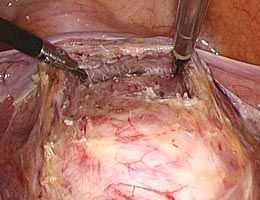
- Intrafascial dissection which proceeds gradually with coagulation of the cervico-vaginal vessels. If a total hysterectomy is scheduled, the Halban's fascia needs to be identified so that closure can be made along two planes.
- Circular opening of the vagina, identified by the uterine manipulator.
- Extraction of the uterus via the vagina
- Vaginal closure along two layers using Vicryl® O suture. The first plane includes only the vaginal mucosa and the second plane covers the first using the peri-cervical fascias. It is essential to suture in two planes in order to properly protect the meshes from any contamination via the vagina.
During supra cervical hysterectomy the cervix is sectioned at the isthmus after coagulating the uterine arteries. Section can be performed by various means. We personally prefer to use the cold knife in an endoscopic blade holder.

Each of the levator ani muscles is included in the suture using Ethibond 0 on a 30 mm needle. The mesh is fixed on both lateral sides.
Once it has been stretched between the two levator ani muscles, the hiatus between the meshes and the vagina is closed by anchoring the meshes to the vaginal wall at the level of the perineal body.
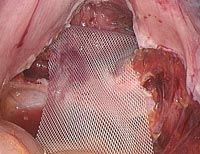
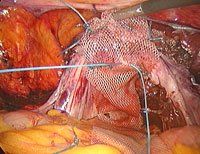
The mesh is then positioned over the posterior aspect of the vagina and fixed to the cardinal ligaments using permanent sutures (Ethibond 0). We avoid stitching the posterior wall of the vagina to prevent any risk of transfixion. Once the mesh has been posteriorly positioned, a McCall type culdoplasty is carried out.
Culdoplasty
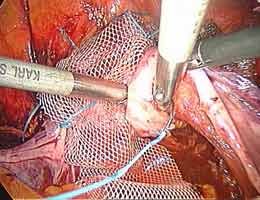
This aim of this procedure is to restore the normal anatomical relationship between the rectum and vagina. The posterior part of the Douglas pouch needs to be closed. This can be achieved with or without Douglassectomy and can be use one or two sutures. The suture material used needs to be permanent, and we recommend Ethibond 0.The first step is to place suture on the thicker and more distal part of the uterosacral ligament, which had been previously tagged. Then the cardinal ligament is included, after checking the ureter's localization. Finally the posterior mesh and the vagina are approximated, then the knot is tightened. This procedure is repeated on the other side. Once this plasty has been completed the vagina will have returned to its normal anatomical position.
Fixing the mesh anteriorly
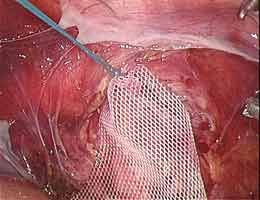
The mesh is spread out in position in the vesico-vaginal space. If the uterus is preserved, the two strips of the mesh are taken down through the windows created in the posterior leaf of the broad ligament. Then they are tied, using a flat knot, behind the isthmus, in the area opened when the recto-vaginal space was dissected.
The mesh is fixed to the anterior vaginal wall by non-transfixing stitches of permanent suture (Ethibond 2/0, on a 18 mm curved needle).
These sutures are tied using half-hitch
extracorporeal knots. Between four and six sutures are needed to ensure that the mesh is firmly anchored.
Lower peritonization
At vaginal level the purpose of the peritonization is to exclude the mesh from the abdominal cavity, placing the bladder over the prosthesis. The suture is started on the left side, using Vicryl 0 suture on a 30 mm curved needle and including the supra vesical peritoneum, the bladder pillar, the lateral vaginal peritoneum then the internal edge of the lateral incision. Using the same suture, this procedure is repeated on the right side. A series of half-hitches knots closes the formed purse, simultaneously closing the peritoneum and lifting the bladder.
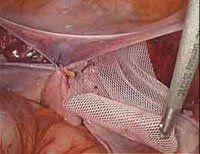

Sacral colpopexy
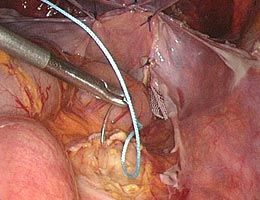
Sacral colpopexy is completed by fixing by means of two stitches of Ethibond 1 suture on a 30 mm curved needle, or staples or Tackers®, the anterior and posterior meshes to the common anterior vertebral ligament at the level of the promontory. The needle must remain visible by "transparency" including only the fibrous layer of the aponeurosis in order to avoid any risk of spondylodiscitis.
Once the sutures have been applied, a firm traction is drawn to check that the anchorage is sufficiently sturdy.

The mesh needs to be fixed in position.
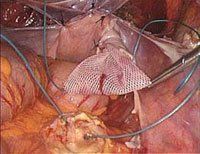
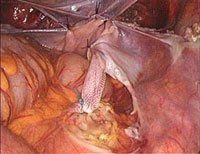
Upper peritonization
The mesh must be totally excluded in a retroperitoneal position. A running suture is therefore needed, including the internal and external edges of the lateral peritoneal incision. We use Monocryl 0 suture on a 30 mm curved needle. This sliding material makes the running suture easy to achieve, but needs several half-hitches to firmly ensure the knot.


Opening the Space of Retzius with a transperitoneal approach
The operation starts by identification of the anatomical landmarks:
-Pubis
-Cooper ligaments
-Upper edge of the bladder identified by the origin of the urachus
The peritoneum is incised above the fundus of the bladder. The incision must run horizontally from one umbilical artery to the other. The assistant applies traction on the peritoneum downwards using a forceps, while the surgeon pulls the plane vertically with the instrument in his right hand and incises with his left hand using scissors connected to the monopolar power source.
The urachus is coagulated then sectioned, afterwards the surgeon progresses vertically towards the abdominal wall, crossing the prevesical-umbilical aponeurosis to enter the Space of Retzius. The Space of Retzius is an avascular plane that is dissected by simple divergent tractions. Pneumodissection helps to open the space. Remaining in contact with the aponeurosis, the surgeon will reach several tissular planes in succession, that will be open down to the fatty tissues located in front of the Cooper ligaments which indicate the upper limit of the Space of Retzius. The right and left Cooper ligaments are dissected. At this point the Space of Retzius is opened by simply opening tissues down until the arcus tendineus fasciae pelvis is found. Dissection continues backwards until just below the obturator fossa. The vaginal walls are pointed out with the help of a finger placed in the fornix until the whitish appearance of the fascia is observed. The edge of the bladder is often revealed by the presence of a vein running along it that must then be carefully separated from the vagina.
Carrying out a para vaginal repair

At this point the positive pressure from the pneumoperitoneum helps to reveal lateral defects which are nearly always present in complex prolapse cases.
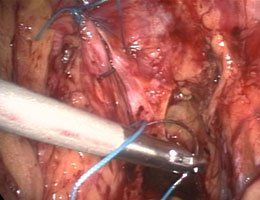
Burch bladder neck suspension
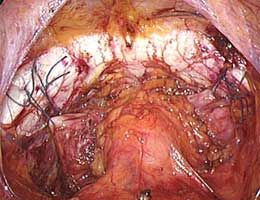
Once the paravaginal repair has been completed, the bladder neck suspension is carried out. The suture used is Ethibond 0 on a 26 mm needle. The suture is applied through the Cooper ligament first, from top to bottom, then through the vagina from inside outwards, trying not to transfix. The passage through the vagina must be sufficiently broad to ensure that the suspension will be sturdy. If there is any bleeding during the first passage, an X shaped stitch is made. In cases in which the sacral colpopexy is performed, a single suture is brought through each side. The tension applied must be moderate. If a para vaginal repair has been carried out, this will prevent any hyper correction caused by the cervico-suspension.
Peritonization
This is systematic and complete. The purpose is to avoid the risk of having bowel trapped in the Space of Retzius. We use Vicryl 0 suture on a 36 mm curved needle. Closure is completed with three runs from right to left. The upper and lower edges of the peritoneum are included in turn then the suture is tied using half-hitches.
Final procedures
Uterine morcellation
Morcellation is necessary after the supra cervical hysterectomy. We use the Steiner morcellation device (Karl Storz, Tuttlingen Germany). The uterus, which is usually small, is cut into 10 mm diameter cylinders which are extracted through the cutting cannula. The specimen is sent for histological examination.
Releasing the attachments
The sutures holding the bowel are released under visual control and any bleeding area is coagulated.
Peritoneal washing
Ringer's Lactate is the best substance to use for this cleaning phase, which must be thorough. All the blood clots are aspirated and any hemostasis still needed is carried out. At the end of the operation, the rinsing liquid must return completely clear.
Cystoscopy
The ureters must be repeatedly checked during the procedure: after hysterectomy, after peritonization and after the Burch procedure. By checking after each phase if there is an injury it will be possible to identify the cause thus helping to achieve the best possible repair. It is also important to pay attention to the color of the urine and to any increase in volume of the urine bag, which could indicate a bladder or ureter injury.
The necessity of performing a cystoscopy at the end of the procedure is debated. Some authors use it systematically whereas others use it only in case of doubt. The indications should be, in any case, wide. Cystoscopy will confirm that the urine is correctly ejaculated from the ureteral meatus which is the only way of certifying that the ureter is intact.
Post operative care
Antibiotic therapy
We do not use post operative antibiotic therapy systematically. We treat only infections that are proven after sampling and an antibiogram.
Prevention of post operative phlebitis
Our patients are given systematic treatment for the prevention of phlebitis. Low dose heparin therapy is started on admission to the hospital the day before the operation, and is continued for 15 days.
Foley catheter
The Foley catheter is left in place for at least 24 hours, and maybe more according to the patient's age and mobility. On removal, a systematic cyto-bacteriologic examination is carried out. Antibiotic therapy is initiated only in the event of urinary infection.
Hospital stay
Hospitalization lasts between 3 to 5 days
Post operative management
The patient is invited to avoid undue exertion after the operation. No strain or carrying of heavy loads is allowed for three months. A normal, hyper-hydrating diet is recommended in order to combat the constipation that is almost always experienced during the three first weeks postoperatively. Sexual relations can be resumed after 6 weeks.
Conclusion
Laparoscopy enables to combine the advantages of prolapse treatment by laparotomy with the low morbidity of the vaginal route. The operating time which initially was extremely time consuming, has now been reduced to about 2 hours, at least in the hands of experienced surgeons. Obviously, further studies are required on long term efficiency and reliability in order to fully evaluate the value of this technique.
References:
References
1. Ameline A, Huguier J. La suspension postérieure du disque lombo-sacré : techniques de remplacement des ligaments utéro-sacrés par voie abdominale. Gynecol Obstet 1957; 56: 94-98.
2. Randall C. Surgical treatment of vaginal inversion. Obstet Gynecol 1971;38: 327-332. (Medline)
3. Nichols D, Milley P. Significance of restauration of vaginal depth and axis. Obstet Gynecol 1970 ; 36 : 251-255. (Medline)
4. Hoff S, Manelfe A, Portet R, Girot C. Promonto-fixation ou suspension par bandelettes transversales ? Etude comparée de ces deux techniques dans le traitement des prolapsus génitaux. Ann Chir 1984 ; 38 : 363-367. (Medline)
5. Baker KR, Beresford JM, Campbell C. Colpo-sacropexy with Prolene Mesh. Gynecol Obstet 1990 ; 171 : 51-54. (Medline)
6. Robert HG. Nouveau traité de techniques chirurgicales gynécologiques. Masson et Cie Ed, 1969, 128-130.
7. Addison WA, Livengood CH, Sutton GP, Parker RT. Abdominal sacral colpopexy with Mercilene Mesh in the retroperitoneal position in the management of posthysterectomy vaginal vault prolapse and enterocele. Am J Obstet Gynecol 1985 ; 15 :140-146. (Medline)
8. Sutton JP, Addison WA, Livengood CH, Hammond CB. Life threatening hemorrhage complicating sacral colpopexy. Am J Obstet Gynecol 1981; 140 : 836-837. (Medline)
9. Caubel P, Lefranc JP, Foulkes H, Pui A, Blondon J. Traitement par voie vaginale des prolapsus génitaux récidivés. J Chir 1989; 126 : 446-470. (Medline)
10. Addison WA, Timmons C, Wall LL, Livengood CH. Failed abdominal sacral colpopexy : observations and recommendations. Gynecol Obstet 1989 ; 74 : 480-842. (Medline)
11. Querleu D, Parmentier D, Delodinance P. Premiers essais de la coelio-chirurgie dans le traitement du prolapsus génital et de l'incontinence urinaire d'effort. In : Les troubles de la statiques pelviennes. Blanc., Boubli L, Baudrant E., D'Ercale C.: Arnette. Paris Ed, 155-158.
12. Wattiez A, Boughizane S, Alexandre F, et al. Laparoscopic procedures for stress incontinence and prolapse. Curr Opin Obstet Gynecol 1995; 7: 317-21. (Medline)
13. Wattiez A, Aimi G, Finkeltin F, et al. Cure chirurgicale des prolapsus vesico-uterins par voie cÅlioscopie exclusive Gunaïkeia 1997 ; 2 : 50-5.
14. Wattiez A, Cucinella G, Giambelli F, Mencaglia L. Laparoscopic Burch procedure for retropubic colposuspension. It J Gynecol Obstet 1997; 9:114-7.
15. Wattiez A, Canis M, Mage G, et al. Promontofixation dans le traitement des prolapsus : intérêt et technique de la voie cÅlioscopie. Journal de Coeliochirugie 1999 ; 31 : 7-11.
Visit TheTrocar.com
Prophylactic methylergonovine reduces blood loss in twin cesarean delivery
February 24th 2025A recent study found that administering prophylactic intramuscular methylergonovine after umbilical cord clamping significantly reduces intraoperative blood loss and hemoglobin drop in twin cesarean deliveries.
Read More
